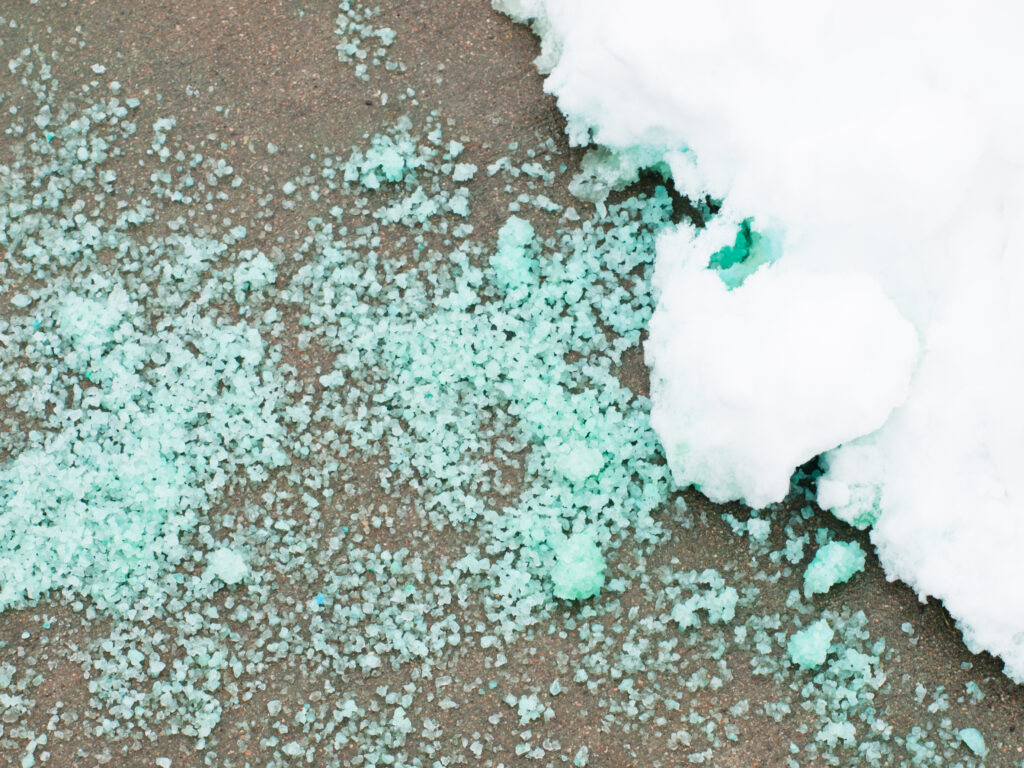Living in the upper-midwest, we’re no strangers to the dangerously slick conditions caused by ice during the winter months. Frozen driveways, steps, and walkways are a leading cause of slips and falls that can cause serious harm, especially to our elderly. To avoid this scenario, we’re accustomed to applying rock salt to concrete. While effective, this treatment is very harmful to concrete and can cause severe damage over time. Regular use of salt on concrete leads to pits, which eventually crack and cause potholes.
Salt also causes corrosion and rust on vehicles, patio furniture, or any metal with which salt comes into contact. Luckily, there are alternatives to salt that can help prolong the life of your concrete and help keep you safe during the winter.

Snowmelt Mats
Admittedly, these aren’t entirely practical or cheap. Still, when dealing with a smaller area prone to ice, a snowmelt mat is a viable solution. These mats come with a heating coil, so they do require a power source, but they don’t pollute the environment like chemical ice melt and can be reused year to year.
Beet Juice
Yes, you read that correctly. Beet juice contains a lot of sugar, and it’s the sugar molecules in beet juice that react to ice. In fact, beet juice has the same reaction as salt to prevent the formation of ice crystals, which is why many municipalities mix beet juice with their road salt to cut down on the amount of salt needed to treat their city streets and roads.
Coffee Grounds
Sometimes, removing ice isn’t feasible, either because of its thickness or its ability to form faster than we can remove it. In those cases, it’s still a good idea to provide some degree of protection from a potentially slippery surface while also being gentle on concrete. Coffee grounds, sand, cat litter, or any gritty substance provide just enough traction to reduce the risk of slipping and sliding. The downside: because these elements don’t melt or dissolve, they can leave a mess.
White Vinegar & Ash Mixture
If you feel like mixing up your own concoction, a homemade ice melt recipe using white vinegar, wood ash, and water melts ice well and is gentle on plant life.
Gather about 2 cups of wood ash from your fireplace or fire pit and dump it into a gallon bucket that’s filled halfway with water, then let this mixture sit overnight.
The next day, filter out any floating debris. Pour what remains into a new bucket and discard any clumps of ash at the bottom. Then stir in 2 cups of white vinegar. Once the mixture is thoroughly combined, pour it into a spray bottle and apply it to the ice.
Protective Sealant
Once cold weather sets in, it’s too late to seal your concrete. But for future reference, a quality sealant can protect concrete surfaces from freeze and thaw cycles that compromise the surface integrity of the concrete. Sealing also protects from dirt, stains, ice melt, oil, and other impurities that seep into porous concrete, making it vulnerable over time.
What concrete-friendly methods do you use to remove ice? We’d love to hear from you, so drop us a line and let us know.



